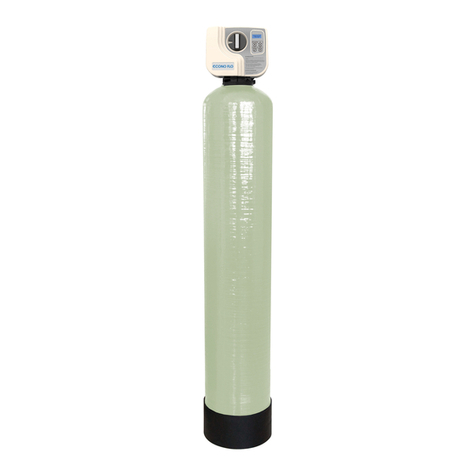The Chem-Free Iron Filter consists of three
major components which are: Control Valve,
Air Tank, Media Tank. Natural oxidation re-
moves iron, sulfur and manganese without
chemicals, air pumps or a venturi.
Incoming raw water passes through a pocket
of air in the first tank. The oxygen in the air
oxidizes the iron into a solid form and it re-
moved when it passes through the second
filter tank. The media in the second filter
tank acts as a catalyst in the reaction be-
tween the iron and oxygen that causes the
iron to precipitate into a solid so it can be fil-
tered out of the water.
As more water passes through the unit, the
air becomes depleted in the first tank and the
filter media in the second tank becomes over
loaded with iron. A periodic automatic re-
generation replenishes a supply of air and
cleans the iron out of the filter tank.
There are no chemicals used for this system
to work. The filter media automatically ad-
justs the pH to neutral or higher on acid wa-
ter without an acid neutralizer. The ability to
raise pH when it is below neutral (7 or less)
greatly enhances the filter’s ability to remove
iron efficiently. The clean, filtered water then
flows into your household water line. De-
pending on water use and the concentration
of iron in your water, periodic backwashing is
required to flush the entrapped iron from the
system. The system can be set to regenerate
as clock every 1 – 99 days or as meter de-
layed based on gallons between regenera-
tions.
Your filter is factory set to backwash at 12:00
a.m. during a period of little or no water use.
The automatic regeneration cycle lasts ap-
proximately 60 minutes, after which filtered
water service is restored. While backwashing
is taking place raw water automatically by-
passes the filter if required. If possible, avoid
using water during backwashing to prevent
iron-laden water entering your household
plumbing system.
IRON (Fe)
Iron concentrations as low as 0.3 ppm will
cause staining. The iron concentration, to-
gether with the flow rate demand and the
consumption rate of the water determines
the basic size filter system. The higher these
factors are, the larger the required system.
The filter system is capable of filtering out
the three main types of iron found in water
supplies: Soluble iron (also known as “clear
water” or ferrous iron), precipitated iron (also
known as “red water” or ferric iron) and bac-
terial iron (also known as iron bacteria).
There is no apparent upper limit of iron con-
centration for the filter, but special care must
be taken when selecting a filter model if your
water has a combination of high iron, very
low pH and/or manganese.
MANGANESE (Mn)
The presence of manganese can be bother-
some, even for a chemical free iron filter. As
little as 0.05 ppm of manganese can produce
a brownish or black stain. The ability of the
filter to remove manganese depends on its
concentration and the pH of the water.
Manganese tends to “coat” the filter media,
rendering it incapable of increasing the pH,
and therefore ineffective in removing either
the iron or the manganese. Manganese, how-
ever, will precipitate in the filter bed when
the pH is increased. To accomplish this a spe-
cial “MN” type media can be provided that
contains additional quantities of the pH rais-
ing component (“MN adder”). The use of
“MN” type media is for applications where
the manganese is not more than 1.5 ppm,
and the pH is at least 6.5.
How The System Works
5




























